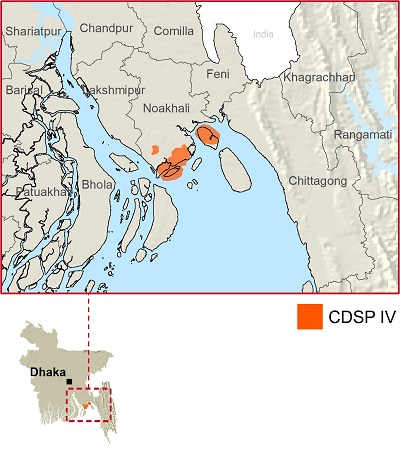Projet de développement et de colonisation des chars – Phase IV
IFAD Asset Request Portlet
Agrégateur de contenus
Projet de développement et de colonisation des chars – Phase IV
Le projet ciblera l'ensemble de la population qui vit sur les îlots côtiers de formation récente (connus localement sous le nom de chars) et bénéficiera du développement de la gestion des eaux, des communications, de l'approvisionnement en eau douce, de protection contre les cyclones et d'autres infrastructures.
Le but du projet sera de réduire la pauvreté et la faim des populations pauvres des chars. Il entend améliorer et sécuriser les moyens de subsistance de 28 000 ménages des chars côtiers. À cette fin, il fournira un appui en faveur des moyens de subsistance ruraux, de l'obtention de titres fonciers et de la mise en place d'infrastructures résistant aux conditions climatiques.
Le projet comprend cinq composantes:
- protection contre le changement climatique;
- infrastructures intérieures;
- colonisation des terres et émission de titres de propriété;
- soutien des moyens de subsistance;
- assistance technique et appui en matière de gestion.
Source: Rapport du Président (22/4/2010)

Rapports du Président
Rapports du Président
Rapports de conception du projet
Documents de supervision et d'appui à l'exécution
Documents de supervision et d'appui à l'exécution
Supervision mission, March 2017
Supervision mission, March 2016
Supervision mission, April 2014
Follow up mission report, September 2013
Supervision mission, March 2013
Étude de l'impact environnemental et social
Étude de l'impact environnemental et social
Cadre de gestion environnementale et sociale
Rapport sur l'examen à mi-parcours
Rapport sur l'examen à mi-parcours
Mid-Term Review Report, May 2015
Cadre d’action de réinstallation
Cadre d’action de réinstallation
Draft Resettlement Action Plan and Framework
Condensé de rapport d'achèvement de projet
Études spéciales
Liste de projets
Audit et états financiers
Audit et états financiers
2023-Ministry of Finance-AUDIT_REPORT
2022-Ministry of Finance-AUDIT_REPORT
2021-Ministry of Finance-AUDIT_REPORT
Rapport d'achèvement de projet
Co-financeurs
À propos du projet
À propos du projet
Merveilleuses zones humides
Les zones humides ont une influence très directe sur notre bien-être – elles protègent contre l'érosion, améliorent la qualité de l'eau et abritent d'innombrables espèces. Partons explorer ces précieux écosystèmes et rencontrer les populations rurales qui les protègent.